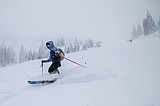Timber tour highlights wood products industry
KATE HESTON | Hagadone News Network | UPDATED 2 years, 2 months AGO
Kate Heston covers politics and natural resources for the Daily Inter Lake. She is a graduate of the University of Iowa's journalism program, previously worked as photo editor at the Daily Iowan and was a News21 fellow in Phoenix. She can be reached at [email protected] or 406-758-4459. | October 22, 2023 12:00 AM
From a giant circular saw that cuts logs to length all the way to an artificial intelligence wood grader, the inside of the F.H. Stoltze Land and Lumber mill is fast and accurate, taking harvested trees and turning them into a revenue-making product.
For some, the flying wood chips and lingering sawdust may be off-putting, but for foresters, it is the fruits of logging labor.
As a part of manufacturing month in October, the Kalispell Chamber of Commerce hosted a tour of F.H. Stoltze’s facility on Wednesday, providing the opportunity to see inside one of the industries that run the state.
“Active forest management is essential for our area and our forests,” said Cameron Wohlschlegel, a land and resources manager at the lumber company. “We need to advocate for active forest management.”
Stoltze Lumber was first established in Montana in 1912 and the current mill location, between Columbia Falls and Whitefish, has been operating since 1923. As a family-owned business, Stoltze creates mainly dry planed lumber, residues like wood chips and sawdust and wood shavings.
In 2022, the company represented 129 employees with 50 loggers, producing 62,128 million board feet of lumber. The majority of the logs come from United States Forest Service land.
The tour began in the sawmill, which runs two sides, two shifts a day. New equipment was installed in 2000, allowing for maximum quality from the logs harvested, according to the lumber company.
The way the mill works, according to Wohlschlegel, is by taking inventory, scaling the product and then sorting it.
A log is cut to size, debarked and squared off — a process that takes multiple big machines. From there, a computer scans the wood, creating a solution for what size lumber to cut. When the log is then split and the lumber is finalized into a flat board, the planks are wrapped and placed outside.
However, every piece gets used when it can, from the wood planks to wood chips to sawdust, which is often sold to timber company Weyerhaeuser to use for manufacturing low-density fiberboard products.
“It’s pretty much full utilization,” Wohlschlegel said. “We use every part of the tree.”
Stoltze also has a co-generation power plant on the property, which runs 24 hours per day, seven days per week and is capable of powering up to 3,000 homes, where tree waste is used to generate power.
“We try to use everything we can out of this plant, including our waste,” said Brad James, power plant superintendent, during the tour.
When the lumber is complete, a lot of it is shipped out to Western Building Center locations or prairie states, like the Dakotas.
BEFORE A log reaches the mill, the work begins in the woods harvesting trees.
The tour visited a log landing near West Glacier, where loggers were actively working on a project for Weyerhaeuser. Before a logging project gets underway, environmental assessments, surveys and more must occur.
“We’re not starting a new forest or taking a whole forest away, we’re just enhancing it,” said Zach Miller, a raw materials manager at Weyerhaeuser.
The goal of forest management, according to both Stoltze and Weyerhaeuser employees, is to better prepare the forest for future use. The projects are prescriptive, in which trees are strategically removed to reduce fuels, especially in the wildland-urban interface.
Loggers remove smaller, weaker trees as well to help the healthier, bigger ones continue to grow. Following best management practices, the logging projects, contrary to what many think, benefit the overall health of the forest, not hinder it, according to Wohlschlegel.
“When we’re not managing the forest, it’s almost like loving something to death,” said Ali Ulwelling, the Montana Forest Action Plan implementation coordinator at the state Department of Natural Resources and Conservation.
Logging, according to Ulwelling, is one way to better prepare a forest for a possible fire. It reduces fuels, gives favor to the healthier, bigger trees and allows for more diversity within the forest stand.
Without management, Ulwelling said, the forest could disappear due to a disaster — something that happened naturally before humans were here. The cycle of the forest would happen without human activity, but by logging and reducing fuels, humans can moderate the extremes while producing a used and valued product, Wohlschlegel said.
Logging operations are strategically timed as well. The Weyerhaeuser landing near West Glacier is a patch of trees that have been growing for around 100 years. By logging them, Wohlschlegel said, that patch will be better prepared to withstand extremes, also providing a home to wildlife.
“The forest is ever evolving,” Wohlschlegel said.
Reporter Kate Heston can be reached at [email protected] or 758-4459.
ARTICLES BY KATE HESTON

Veteran-owned mobile boat repair service anchors down in the Flathead Valley
The Kramers launched Flathead Mobile Marine to use their skills — they have decades of experience performing routine maintenance checks on a variety of boats as well as working with engines and electrical systems — and help boaters in the community.

With ski season near, resort reaches deal with staff
After 18 months of negotiations, Whitefish Mountain Resort executives and the resort’s ski patrol union are finalizing a one-year contract for the upcoming season.

Trapped in a car wreck, Woods Bay woman credits teens with saving her life
Driving home from a quilting event in Bigfork in September of last year, Carol Martin remembered that the sky was clear, the sun was shining, and she had a headache.













